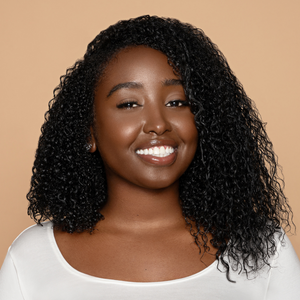
Recently on the NaturAll blog, we discussed the truth about shampoo and the potential harms and benefits shampoo can have for your hair.
In that article, we mentioned apple cider vinegar (ACV) as a beneficial ingredient for curly, kinky, or natural hair. This concept might be new to you, or you might just be hesitant to wash your hair with vinegar (understandable!) so let’s explore the science of apple cider vinegar rinses for natural hair, and how to do them!

First: what makes a healthy, balanced scalp?
Your scalp has a natural pH level of about 5, which is slightly acidic. This acidity level is important in keeping the cuticle layer of your hair flat and closed. A flat cuticle layer corresponds to shiny, smooth, soft hair, with less frizz. It prevents tangling, breakage, dryness, and hair loss, by helping each individual hair strand retain moisture and making them smooth and less likely to catch on each other.
However, many shampoos and other hair products have a more alkaline pH (above 7), which disrupts the acidity level of the scalp. The cuticle layer responds by opening up, becoming susceptible to dryness, breakage, frizz, tangling, etc. This can be especially problematic for natural hair and curly hair.
You can regulate the pH of your scalp and prevent many of the negative effects of alkaline hair products by doing ACV rinses! ACV has a pH of about 3, but diluted with water it will be close to the normal acidity of your scalp.

The Benefits of Apple Cider Vinegar
- Apple cider vinegar balances hair and scalp pH. By lowering the pH of your scalp, ACV flattens and closes the hair cuticle. This makes your hair smoother and easier to detangle, shinier, less frizzy, less prone to breakage, and more moisturized. While ACV cannot lower the natural porosity of your hair or repair holes in the cuticle layer caused by heat or chemical damage, it flattens the hair cuticle to mitigate the effects of high porosity hair.
- Apple cider vinegar helps prevent fungal and bacteria growth and keeps the hair and scalp healthy. It is anti-inflammatory and can help with dandruff and hair loss, since the underlying cause is often bacteria.
- Apple cider vinegar also contains nutrients (vitamins B, C, and potassium), which are beneficial for your hair.
- Apple cider vinegar clarifies and exfoliates your scalp, removing dead skin as well as product buildup that blocks the pores on your scalp.
- Apple cider vinegar can also help with volume and curl definition, since it doesn’t weigh down strands like silicone-based conditioners.
- Apple cider vinegar stimulates hair growth by increasing blood circulation to hair follicles.
- Apple cider vinegar is cost-effective and does not contain any preservatives or added chemicals that might damage your hair!

Common misconceptions about Apple Cider Vinegar
- “You can use ACV as a substitute for shampoo.” This is not completely true. While ACV is an effective clarifier and exfoliant, it does not do the full job of cleansing your hair. Alternate ACV rinses with shampoo, or do an ACV rinse directly after shampooing your hair. If you're worried about shampoo stripping your hair, opt for a mild, sulfate-free, cleansing shampoo.
- “ACV is too acidic and will damage your hair.” This is technically true- if you use undiluted apple cider vinegar. Pure ACV is extremely acidic and will definitely start degrading your hair, and we don’t recommend using diluted ACV more often than once a week. However, diluted with water and used occasionally, ACV is very beneficial for your hair!
- “ACV treatments will leave your hair smelling like vinegar.” This one is false: as long as you rinse the treatment out, your hair will smell normal.

How To Do An Apple Cider Vinegar Rinse
- Choose an organic, raw, unfiltered brand of ACV. The vinegar should be slightly cloudy rather than clear, and contain a small amount of sediment (called ‘the mother.’) This is where all the nutrients live! Give the bottle a shake before you begin.
- You can do the ACV rinse right after shampooing your hair, or on unwashed hair (just remember, your hair does need to be cleansed from time to time!) If you aren’t cleansing your hair first, dampen your hair before you begin.
- Mix raw ACV with water, using a 1-3 ratio (ex: 1 tbsp ACV and 3 tbsps water, or 1 and 3 cups respectively if you’d like to make a larger volume.)
- The mixture is easiest to apply using a spray bottle or a bottle with a very small opening. Apply throughout damp or wet hair, from roots to ends. Massage your scalp to stimulate blood circulation and to help with exfoliation.
- Let the mixture sit in your hair for about 5 minutes, and rinse out thoroughly.
- Pay attention to how the treatment affects your hair! You can do it as often as once a week, or just once every several months. We recommend starting out by doing the treatment every two weeks or so, and adjusting the frequency to what feels best for your hair.













